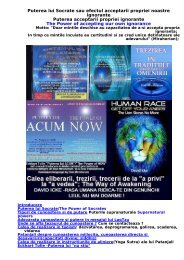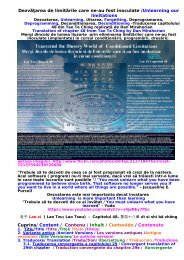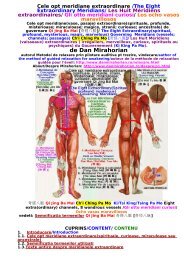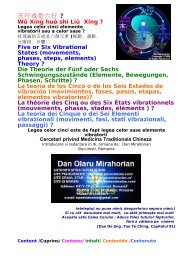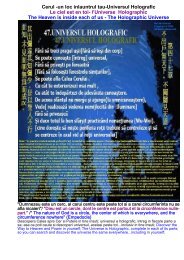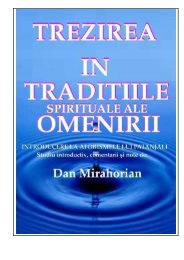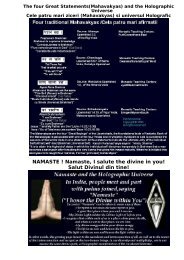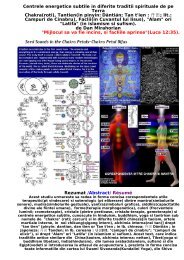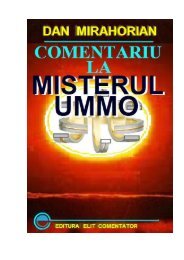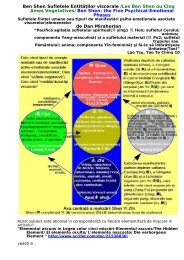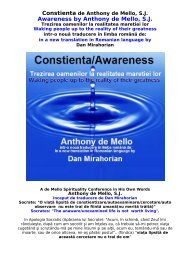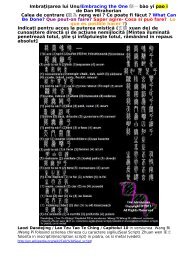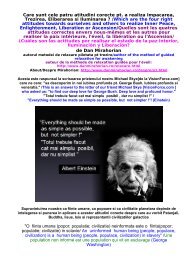prezentarea metodei de relaxare pilotata - Mirahorian
prezentarea metodei de relaxare pilotata - Mirahorian
prezentarea metodei de relaxare pilotata - Mirahorian
You also want an ePaper? Increase the reach of your titles
YUMPU automatically turns print PDFs into web optimized ePapers that Google loves.
Learning Anapana plants a wholesome interest in self-introspection and meditation, which<br />
may open an entirely new dimension of life as well as providing children with a tool that will<br />
be of immense value to them for the rest of their lives. Children's courses are one-day<br />
courses open to all children aged 8-12yrs who wish to learn to meditate. Teenager's<br />
courses may range in length from one to three days and are open to children aged 13-<br />
16yrs. Parents/guardians do not have to be meditators. These courses have been<br />
specifically <strong>de</strong>signed for children and the schedule and activities crafted to embrace the<br />
dynamics of the particular age group<br />
Anapana(breath) Sati(attention exercise) is the mindfulness of the in and out breath. This<br />
is the first subject of meditation mentioned in Maha Satipattana Sutta among 40 subjects<br />
given for concentration. It should be emphasized that Anapana Sati is not a breathing<br />
exercise. What is required is the observation of the natural in and out breath and not the<br />
<strong>de</strong>liberate un<strong>de</strong>rtaking of breathing. Although this is the standard advice given for the<br />
practice of this meditation, there is a ten<strong>de</strong>ncy among many to control or force the breath<br />
which makes the breathing uncomfortable. If one observes the breath not in formal posture<br />
but when relaxing informally, it would be noticed at such times that the breath is natural but<br />
when sitting formally it is strained. What is expected in this meditation is for the breath to do<br />
the breathing while the meditator just observes without interference noting the short in<br />
breath and the short out breath, the long in breath and the long out breath.<br />
In the Anapana Sati Sutta, there is no reference to locate the in and out breadth at any<br />
particular point but merely states how to arouse mindfulness on the object of meditation,<br />
namely, arouse mindfulness in front - Satin Upatthapetva. However, in the Patissambhida<br />
Magga, which is a part of the Abhidhamma, it is recor<strong>de</strong>d that the Buddha has stated to<br />
focus attention at the point below the nostrils and above the upper lip. Later, since certain<br />
communities found it difficult to locate the breath at the tip of the nostrils due to their natural<br />
facial structure, they were advised to focus attention on the and fall of the abdoman.<br />
Anapana Sati meditation; is conducive for the concentration of the mind and has the<br />
advantage to shift from mere observation of the breath which is Samitha (tranquillity)<br />
meditation to Vipassana (insight meditation) by contemplating on the three characteristics of<br />
life of Anicca, Dukkha and Anatta or impermanence, unsatisfactoriness and absence of a<br />
permanent eternal, self or ego.<br />
Vipassana<br />
However, this Jhanas(Anapana Sati) would not lead to <strong>de</strong>liverance from Dukkha for all time.<br />
When in the Jhana, there is freedom from dukkha but one cannot be in Jhana for ever. For<br />
<strong>de</strong>liverance on a continuous basis one should practice insight meditation (Vipassana<br />
Bhava). For that, when the mind is calm and tranquil with <strong>de</strong>ep concentration on the in and<br />
out breath, one should shift from tranquillity meditation to insight meditation. One way to do<br />
so is when the mind strays from the breath to pain and discomfort one may experience<br />
having been in the seated position for a consi<strong>de</strong>rable period. Here, instead of bringing the<br />
mind back to the object of meditation, one could concentrate on the discomfort, its increase<br />
or <strong>de</strong>crease or remaining the same. After a time, attention would shift to another area of the<br />
body where discomfort is experienced to a greater <strong>de</strong>gree. One could also observe the<br />
feelings that arise, some pleasant, others unpleasant or neutral. There is arising and<br />
ceasing. Similarly, it could be noted whether the thought that arise in the mind is<br />
wholesome, unwholesome or neutral. This arising and ceasing of feelings, thoughts and<br />
phenomena would bring to the forefront, the impermanence and changing character of all<br />
things leading to the realization of the unsatisfactory nature of life when even happiness is<br />
temporary and consequently unsatisfactory. And on account of the impermanent nature of<br />
all phenomena, the absence of a permanent, unchanging, eternal self, ego or soul realized.<br />
see more on:<br />
http://patanjali1.multiply.com/<br />
http://www.myspace.com/patanjaliyoga



